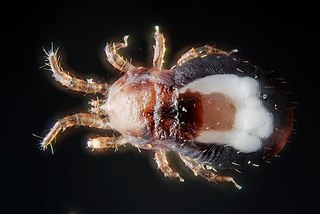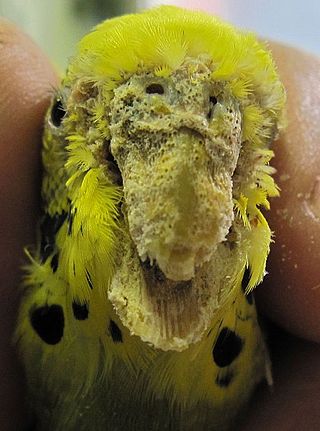
Mites are small arachnids. Mites span two large orders of arachnids, the Acariformes and the Parasitiformes, which were historically grouped together in the subclass Acari. However, most recent genetic analyses do not recover the two as each other's closest relative within Arachnida, rendering the group non-monophyletic. Most mites are tiny, less than 1 mm (0.04 in) in length, and have a simple, unsegmented body plan. The small size of most species makes them easily overlooked; some species live in water, many live in soil as decomposers, others live on plants, sometimes creating galls, while others are predators or parasites. This last type includes the commercially destructive Varroa parasite of honey bees, as well as scabies mites of humans. Most species are harmless to humans, but a few are associated with allergies or may transmit diseases.
Acariasis is an infestation with mites.

Cheyletiella is a genus of mites that live on the skin surface of dogs, cats, and rabbits.

Eczema herpeticum is a rare but severe disseminated infection that generally occurs at sites of skin damage produced by, for example, atopic dermatitis, burns, long-term usage of topical steroids or eczema. It is also known as Kaposi varicelliform eruption, Pustulosis varioliformis acute and Kaposi–Juliusberg dermatitis.

Dermanyssus gallinae is a haematophagous ectoparasite of poultry. It has been implicated as a vector of several major pathogenic diseases. Despite its common names, it has a wide range of hosts including several species of wild birds and mammals, including humans, where the condition it causes is called gamasoidosis. In both size and appearance, it resembles the northern fowl mite, Ornithonyssus sylviarum.

The flour mite, Acarus siro, a pest of stored grains and animal feedstuffs, is one of many species of grain and flour mites. An older name for the species is Tyroglyphus farinae.

Steroid-induced rosacea is an iatrogenic condition from the use of either systemic steroid or topical steroids. It is nearly identical to steroid induced acne from the standpoint of etiology.

Scaly foot, or knemidocoptiasis is a bird ailment that is common among caged birds and also affects many other bird species. It is caused by mites in the genus Knemidokoptes which burrow into the bird's flesh. The tunnels made by the mites within the skin cause dermatitis and scaly lesions. Scaly face is caused by the same mite responsible for scaly foot and other related mites cause depluming. The condition is transmitted from one bird to another by direct prolonged contact.
Sea anemone dermatitis is a cutaneous condition similar to jellyfish and hydroid dermatitis, caused by contact with certain sea anemones.
Grocer's itch is a cutaneous condition characterized by a pruritic dermatitis that occurs from coming into contact with mites such as Carpoglyphus passularum or Glycyphagus domesticus. Contact usually occurs when handling food with mites in it, such as figs, dates, prunes, grain, cheese, or other dried foods.
Tulip fingers are a cutaneous condition, a combined allergic and irritant contact dermatitis caused by contact with tulip bulbs.

Ornithonyssus bacoti is a hematophagous parasite. It feeds on blood and serum from many hosts. O. bacoti can be found and cause disease on rats and wild rodents most commonly, but also small mammals and humans when other hosts are scarce. Outbreaks tend to occur in older, less maintained buildings. The mite, however, can travel several hundred feet on its own if necessary to find a host and can survive for extended periods of time without a host. This, along with the nonspecific dermatitis it causes, can prevent accurate and fast diagnosis of rat mite dermatitis. The scarcity of reports, due in part to misdiagnosis and also the mildness of its symptoms, makes the disease seem less common than it is. The tropical rat mite can be found in both temperate and tropical regions or rather all continents except the Arctic and Antarctic.
Liponyssoides sanguineus is a species of mite that infests the house mouse.

Pyroglyphidae is a family of non-parasitic mites. It includes the house dust mite that live in human dwellings, many species that live in the burrows and nests of other animals, and some pests of dried products stored in humid conditions.
Jay R Traver was a University of Massachusetts entomologist who studied and published about mayflies. She described over 200 new species and contributed to the reorganization of the systematics of the entire order. She has been called "the first Ephemeroptera specialist in North America".
Baker's itch is a cutaneous reaction caused by bites of Acarus siro, the flour mite.

Peptidase 1 (mite) (EC 3.4.22.65), also known as endopeptidase 1 (mite), is an enzyme found in various species of mites. This enzyme exhibits cysteine protease activity with broad endopeptidase specificity.

Mites that infest and parasitize domestic animals cause disease and loss of production. Mites are small invertebrates, most of which are free living but some are parasitic. Mites are similar to ticks and both comprise the order Acari in the phylum Arthropoda. Mites are highly varied and their classification is complex; a simple grouping is used in this introductory article. Vernacular terms to describe diseases caused by mites include scab, mange, and scabies. Mites and ticks have substantially different biology from, and are classed separately from, insects. Mites of domestic animals cause important types of skin disease, and some mites infest other organs. Diagnosis of mite infestations can be difficult because of the small size of most mites, but understanding how mites are adapted to feed within the structure of the skin is useful.

Dust mite allergy, also known as house dust allergy, is a sensitization and allergic reaction to the droppings of house dust mites. The allergy is common and can trigger allergic reactions such as asthma, eczema or itching. The mite's gut contains potent digestive enzymes that persist in their feces and are major inducers of allergic reactions such as wheezing. The mite's exoskeleton can also contribute to allergic reactions. Unlike scabies mites or skin follicle mites, house dust mites do not burrow under the skin and are not parasitic.











